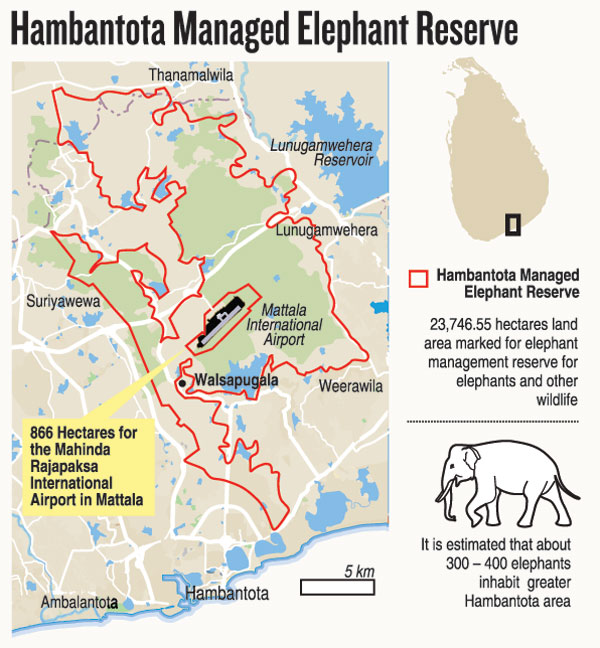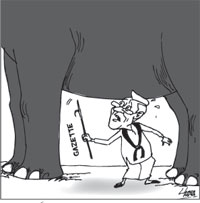News
Farmers surprised by elephant reserve move

Banners and posters at the site of the sathyagraha in Walsapugala, Hambantota. Pix by Rahul Samantha
Farmers said they were taken by surprise by the gazette issued on April 9 establishing the Hambantota Managed Elephant Reserve despite having been in talks on human-elephant conflict amelioration with Irrigation Minister Chamal Rajapaksa.
Walawa Left Bank Joint Farmers’ Association President Mahinda Samarawickrema said the gazette issued by State Minister Wimalaweera Dissanayake stated the reserve covered an area of 23,746 hectares more than the 25,000ha declared in the original allocation.
Minister Rajapaska had assured farmers that he would discuss matters with them before the elephant reserve was declared, he claimed. “The Minister promised a complete package of establishing an electric fence with lights, and a road around the reserve, and establishing dedicated bee, milk and watermelon farming villages,” Mr. Samarawickrema said.
“Milk farmers should have grasslands for their cows, and these areas should be clearly marked in the map issued with the gazette,” the farmers’ leader said.
Farmers needed assurance followed by concrete action on the management of wild elephants within an agreed time frame. Otherwise, the farmers’ satyagraha campaign in Walsapugala, Hambantota, launched on January 18, would continue.
Mr. Samarawickrema said he found it suspicious that the gazette had been issued with an outdated map showing the demarcated area of the proposed elephant reserve. “This is an old map. It doesn’t show the expressways to Hambantota Harbour or to Mattala Airport, nor does it depict the number of reservoirs where animals quench their thirst,” he said.
Farmers object to the previously undisclosed reservation of some 1,700ha, allegedly for development, without any purpose mentioned for the development. “Another 2,600 acres had been given to some foundation,” the farmers’ leader charged. “We were not informed as to from where and for what purpose these lands are going to be acquired.”
He said there were two large-scale solar electricity farms and quarries inside the reservation that were not depicted. “These things should be clearly shown on the map,” Mr. Samarawickrema said.

The farmers engaged in the satyagraha are demanding: the gazetting of the Hambantota Elephant Management Reserve; erection of an electric fence around the reserve; relocation of wild elephants who roam into villages; a stop to the exploitation by large-scale commercial cultivators of water sources used by traditional farmers; allocation of grasslands for grazing of milk cows; a stop to claimed extensive politically-backed land-grabbing in Hambantota.
“We are fighting for these demands but no politician or government official informed us about the gazette coming out,” Mr. Saramawickrema said. “We only came to know about it through the media.”
 Out of 21 grama niladhari divisions in the Sooriyawewa Divisional Secretariat area, 17 are affected by wild elephants while Ambalantota, Hambantota and Sevanagala and Lunugamvehera, Thanamalvila Divisional Secretariat areas and Hambantota Municipal Council area constantly experience elephant attacks.
Out of 21 grama niladhari divisions in the Sooriyawewa Divisional Secretariat area, 17 are affected by wild elephants while Ambalantota, Hambantota and Sevanagala and Lunugamvehera, Thanamalvila Divisional Secretariat areas and Hambantota Municipal Council area constantly experience elephant attacks.
Mr. Saramawickrema claimed that recently a large but unspecified amount of land had been illegally acquired in or close to the reserve by parties backed by politicians. Blocks of 40 acres and 50 acres had acquired by companies.
“How the district and divisional secretaries helped them to illegally acquire those lands within the reserve should be investigated,” he alleged, adding that both government and opposition were responsible for illegal land-grabbing inside the management reserve.
Mr. Samarawickrema said the initial allocation of forest land for the proposed elephant management reserve was 25,000ha. This move, in 2011, followed large-scale clearing of forests around Hambantota area in 2005 that caused a rise in human-elephant conflict and led to the formulation of a national policy on conservation of wild elephants in 2006.
| Report warned rushed projects would harm jumbos A high-level report in 2018 warned that expedited development projects in the Hambantota area would affect the survival of elephants. In his Performance Report on Department of Wildlife March 2018, then Auditor General H.M. Gamani Wijesinghe stated, “As the wild elephant management reserve in Hambanthota was not declared, the expedited development projects taking place in those areas [had a severe impact] on the corridors and habitats of fauna including wild elephants. As such, it is concluded that human-elephant conflict in such areas will escalate.” This forecast proved to be too true as the following year saw the worst in human-elephant conflict, with 405 elephant deaths by humans and 121 human deaths by elephants, according to the Department of Wildlife. Most deaths were caused by human encroachment into elephant habitats, the fragmentation of habitats and deprivation of the elephants’ natural grounds and movement. The report found that the authorities had failed to establish the proposed Hambantota Wild Elephant Management Reservation for the protection of wild elephants prior to the construction of the Hambantota Harbour and Mattala Airport as required by the Environment Impact Assessment Reports of both projects. Sri Lanka recorded the highest annual elephant deaths and second highest human deaths in the world last year, according to the Parliamentary Committee of Public Accounts (COPA). Environment activist and lawyer Raveendranath Dabare called for island-wide reserves facilitating the unhindered movement of elephants without human interference. “We have filed a writ application in the Court of Appeal seeking orders compelling relevant authorities to set up country-wide elephant management reserves based on years-long scientific observations of movement of elephants,” he explained. He noted that construction of electric fences should only be carried out by government authorities. “The erection of electric fences by individuals and private parties haphazardly everywhere has aggravated human-elephant conflict,” he stressed. | |


